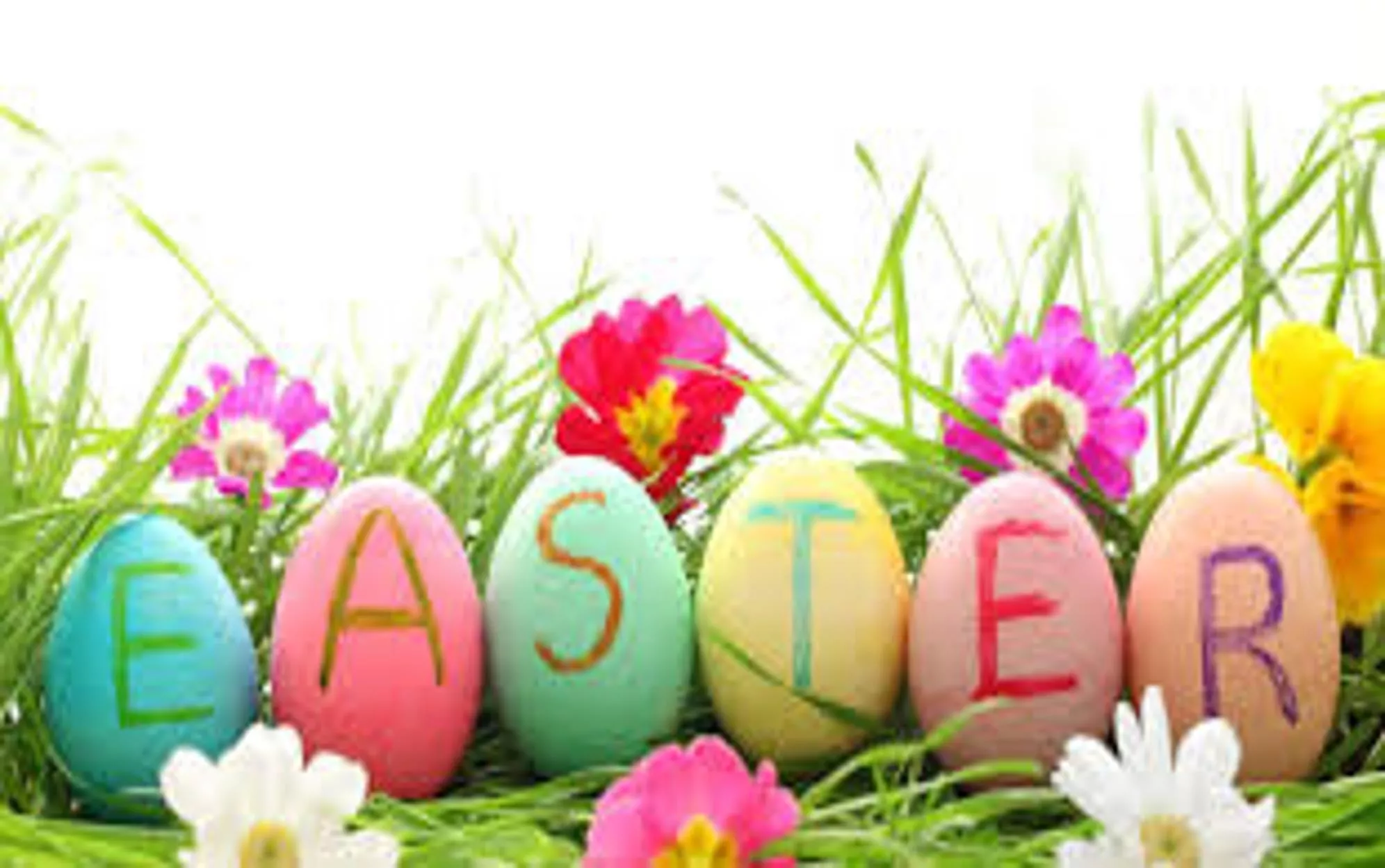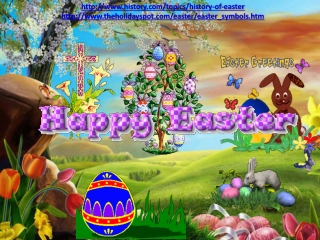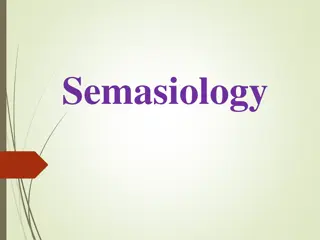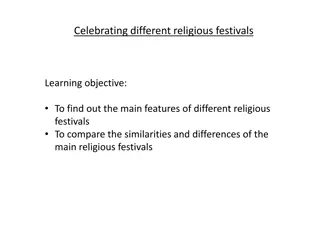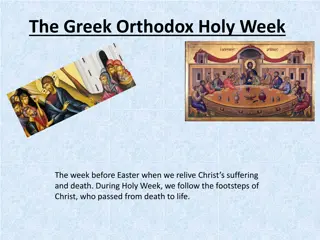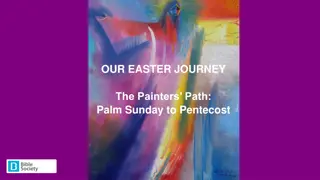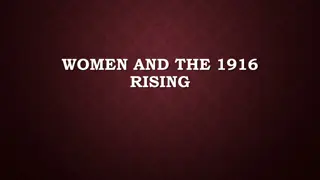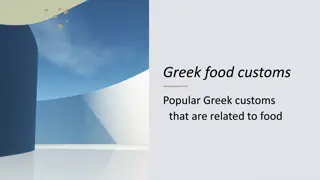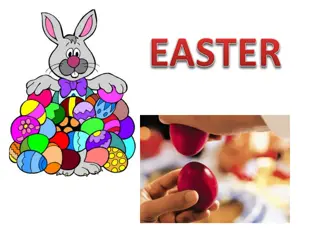The Meaning and History of Easter
Easter is a significant Christian celebration symbolizing the resurrection of Jesus from the dead. It follows a period of fasting called Lent and includes events such as Palm Sunday, Maundy Thursday, and Good Friday. The origin of the word "Easter" is uncertain, with various theories tying it to different cultural and historical sources. Easter holds profound religious significance and serves as a time for renewal of hope and faith in Christianity.
Download Presentation

Please find below an Image/Link to download the presentation.
The content on the website is provided AS IS for your information and personal use only. It may not be sold, licensed, or shared on other websites without obtaining consent from the author.If you encounter any issues during the download, it is possible that the publisher has removed the file from their server.
You are allowed to download the files provided on this website for personal or commercial use, subject to the condition that they are used lawfully. All files are the property of their respective owners.
The content on the website is provided AS IS for your information and personal use only. It may not be sold, licensed, or shared on other websites without obtaining consent from the author.
E N D
Presentation Transcript
What is Easter? Easter is the celebration of the resurrection of Jesus from the tomb on the third day after his crucifixion. Easter is the fulfilled prophecy of the Messiah who would be persecuted, die for our sins, and rise on the third day. Remembering the resurrection of Jesus is a way to renew daily hope that we have victory over sin. According to the New Testament, Easter is three days after the death of Jesus on the cross. Easter follows a period of fasting called Lent, in which many churches set aside time for repentance and remembrance. Lent begins on Ash Wednesday and ends on Good Friday, the day of Jesus' crucifixion. The 40 day period was established by Pope Gregory 1 using the 40-day pattern of Israel, Moses, Elijah and Jesus' time in the wilderness.
The week leading up to Easter is called The Holy Week, or "Passion Week", and includes Palm Sunday (the day Jesus entered Jerusalem and was celebrated), Maundy Thursday (the "Last Supper" where Jesus met with his disciples to observe Passover), and Good Friday (when Jesus would be crucified on the cross). Easter is a very significant date within Christianity and is the foundation of the Christian faith. Jesus, the Son of God, fulfilled prophecy and through his death, has given the gift of eternal life in heaven to those who believe in his death and resurrection.
What does Easter mean? The origin of the word easter isn t certain. The Venerable Bede, an eighth-century monk, and scholar, suggested that the word may have come from the Anglo-Saxon Eeostre or Eastre a Teutonic goddess of spring and fertility. Recent scholars haven t been able to find any reference to the goddess Bede mentioned and consider the theory discredited. Another possibility is the Norse eostur, eastur, or ostara, which meant the season of the growing sun or the season of new birth. The word east comes from the same roots. In this case, easter would be linked to the changing of the season.
A more recent and complex explanation comes from the Christian background of Easter rather than the pagan. The early Latin name for the week of Easter was hebdomada alba or white week, while the Sunday after Easter day was called dominica in albis from the white robes of those who had been newly baptized. The word alba is Latin both for white and dawn. People speaking Old High German made a mistake in their translation and used a plural word for dawn, ostarun,instead of a plural for white. From ostarun we get the German Ostern and the English Easter.
Origin and history of the Easter bunny What is the first thing that comes to mind when you think of Easter? As a Christian, the first image might be the cross or the empty tomb. For the general public, a blitz of media images and merchandise on store shelves makes it more likely that the Easter Bunny comes to mind. So how did a rabbit distributing eggs become a part of Easter? There are several reasons for the rabbit, or hare, to be associated with Easter, all of which come through pagan celebrations or beliefs. The most obvious is the hare s fertility. Easter comes during spring and celebrates new life. The Christian meaning of new life through Christ and a general emphasis on new life are different, but the two gradually merged. Any animals like the hare that produced many offspring were easy to include.
The hare is also an ancient symbol for the moon. The date of Easter depends on the moon. This may have helped the hare to be absorbed into Easter celebrations. The hare or rabbit s burrow helped the animal s adoption as part of Easter celebrations. Believers saw the rabbit coming out of its underground home as a symbol for Jesus coming out of the tomb. Perhaps this was another case of taking a pre-existing symbol and giving it a Christian meaning.
Origin and history of Easter Eggs Next to the Easter bunny, the most familiar symbol is the Easter egg. Like others, the egg has a long pre- Christian history. Again there s no certainty as to why it became associated with Easter. Many Ancient cultures viewed eggs as a symbol of life. Hindus, Egyptians, Persians, and Phoenicians believed the world begun with an enormous egg. The Persians, Greeks, and Chinese gave gifts of eggs during spring festivals in celebration of new life all around them. Other sources say people ate dyed eggs at spring festivals in Egypt, Persia, Greece, and Rome. In ancient Druid lore, the eggs of serpents were sacred and stood for life.
Early Christians looked at the connection that eggs had to life and decided eggs could be a part of their celebration of Christ s resurrection. In addition, in some areas, eggs were forbidden during Lent; therefore, they were a delicacy at Easter. Since many of the earlier customs were Eastern in origin, some speculate that early missionaries or knights of the Crusade may have been responsible for bringing the tradition to the West.
In the fourth century, people presented eggs in church to be blessed and sprinkled with holy water. By the twelfth century, the Benedictio Ovorum had been introduced authorizing the special use of eggs on the holy days of Easter. The timing of this blessing would uphold the idea that Crusaders may have brought the tradition back. Even though eggs had been used previously, the Crusaders may have made the custom more popular and widespread. In 1290, Edward I of England recorded a purchase of 450 eggs to be colored or covered with gold leaf. He then gave the eggs to members of the royal household.
Once the custom became accepted, new traditions began to grow up around it. Eggs were dyed red for joy and in memory of Christ s blood. Egg rolling contests came to America from England, possibly as a reminder of the stone being rolled away. What about the familiar Easter Egg hunt? One source suggested that it grew out of the tradition of German children searching for hidden pretzels during the Easter season. Since children were hiding nests for the Easter Bunny to fill with eggs at the same time they were hunting pretzels, it was only a small leap to begin hiding eggs instead.
The Easter Lamb Of all Easter symbols, the lamb is probably the most strongly Christian. Other than the fact that lambs are young animals born in springtime, it has no strong ties to pagan traditions. The lamb comes from the Jewish Passover, where each family killed a lamb as a sacrifice. When Christ became the Passover Lamb for everyone, the lamb became a symbol for His sacrifice.
John 1:29 - "The next day John saw Jesus coming toward him and said, Look, the Lamb of God, who takes away the sin of the world!" 1 Peter 1:18-21 - "For you know that it was not with perishable things such as silver or gold that you were redeemed from the empty way of life handed down to you from your ancestors, but with the precious blood of Christ, a lamb without blemish or defect. He was chosen before the creation of the world, but was revealed in these last times for your sake. Through him you believe in God, who raised him from the dead and glorified him, and so your faith and hope are in God."
1. Whip-cracking in the Czech Republic and Slovakia If you're a woman and you find yourself in the Czech Republic or Slovakia on Easter Monday, it is perhaps best to stay indoors. All the local men and boys will be roaming the streets with gaily decorated willow switches, usually adorned with ribbons, looking for girls to 'lightly' whip. The whipping is not intended to be painful, but instead is meant to encourage good health and beauty. You may feel otherwise.
2. The butter lambs of Russia In Russia, the Easter meal is accompanied by a knob of butter fashioned into the shape of a lamb. It dates back to ancient times when it was considered a lucky omen to meet a lamb. Why a lamb? Because you can be certain it's not Satan in disguise. Old Beelzebub can take on the form of all animals, except the lamb because of its religious symbolism.
3.A feast unlike any other in Colombia Colombians are a hardy and perverse lot. The temptation of chocolate eggs and bunnies is non-existent. They observe Easter by tucking into iguana, turtles and big rodents.
4.The world's biggest Easter omelette in France Every Easter Monday, the residents of Haux crack more than 4,500 eggs into a gigantic pan to create a massive Easter omelette that serves over 1,000 people. Each family breaks the eggs in their homes in the morning and they gather in the main square where the eggs are cooked for lunch. And dinner. And breakfast the next morning...
5.A time to splash out, Hungary In Hungary, women dress up in traditional clothes on Easter Sunday and get splashed with water. Uncomfortable, yes. But it certainly beats getting whipped.
6.The witches of Easter-wick in Finland Halloween comes early to Finland as children dress up as witches and wander the streets with broomsticks in the hunt for treats. The tradition is said to have come from the belief that witches would fly to Germany and cavort with Satan. Bonfires are meant to scare them away.
7.Tobacco trees in Papua New Guinea Chocolate isn't much use in the steamy jungles of Papua New Guinea, so Easter trees at the front of churches are decorated with sticks of tobacco and cigarettes instead. These are handed out after the service.
8. The Easter Bunny sees red in Greece Easter is known around the world for multi- coloured, decorated eggs. But in Greece you will find only red eggs. Red is the colour of life, you see, as well as a representation of the blood of Christ. From ancient times, the egg has been a symbol of the renewal of life, and the message of the red eggs is victory over death.
9.Criminal intent in Norway Easter time is crime time in Norway. Television channels run crime shows and a slew of new detective novels are commissioned to come out just before Easter. People across the country escape into their mountain cabins and spend the weekend with the Whodunnit television shows or books. Even the milk cartons carry short detective stories on their side during the season. The phenomenon was triggered by the immense popularity of a crime novel in 1923, set on the Bergen railway.


